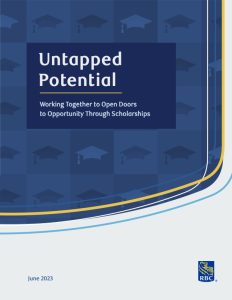|
Getting your Trinity Audio player ready...
|
For many young people in Canada, post-secondary education is a catch-22. While a university or college degree increases an individual’s earning potential in the long term, the high cost of living and attending post-secondary pose significant barriers to both accessing and succeeding in school – particularly for certain student populations.
Post-secondary education: Opportunities and obstacles
One of the key reasons students decide to attend post-secondary education is to prepare for the job market. Although the transition can be complex and challenging, most students do begin working after graduating. Almost 90% of both college and university graduates were employed three years after graduating and about 80% were working in their chosen fields, according to the 2018 National Graduates Survey. Post-secondary graduates experience an “earnings premium,” earning more than peers without post-secondary education. This is especially true for students from the lowest-income families. Compared to their counterparts who did not attend post-secondary, graduates earned $33,000 more with a university degree and $15,000 more with a college degree.

But what about scholarships? Surely, students can access crucial funding to support their post-secondary journey. Well, yes and no.
While scholarships, bursaries and awards can be instrumental in helping young people finance their post-secondary education, many still face significant hurdles in accessing them. And there is little knowledge around the collective impact of scholarships in Canada and the roles they play and could play.
In response to this reality, RBC Future Launch produced a report, Untapped Potential: Working Together to Open Doors to Opportunity Through Scholarships, which examines Canada’s scholarships landscape. The report aims to close key information gaps and provide recommendations to help remove obstacles to success, so students can flourish and better contribute to a prosperous Canadian economy.
Farahnaaz Kanji will be moderating a free, CERIC-hosted webinar on “Opening Doors to Opportunity Through Scholarships” on Oct. 28. Learn more and register at ceric.ca/webinars.
Barriers to student success in the scholarship ecosystem
Scholarships play a significant role in supporting students by covering costs and lessening the barriers they face in entering and succeeding at post-secondary school. Yet, while tens of thousands of scholarships are available each year for undergraduate students in Canada, very little has been written about how much scholarship funding is available, how these types of funds work together (or with government student financial aid systems) and how they can help young people prepare for the future.
In fact, there is a consistent lack of up to date, disaggregated, relevant and public data on the post-secondary ecosystem, which is particularly true for scholarships. Plus, students receive little guidance on navigating the scholarship ecosystem – as a result, they are burdened by inconsistent application processes and complexity. In addition, new providers of scholarships have little access to information to understand whether their funding may be impactful, strategic and relevant. Innovative scholarship programs are difficult to scale.
The Untapped Potential report uncovered the following key findings:
- The scholarship ecosystem is vast, complex and hard to decipher. It is difficult for young people to navigate and creates even more barriers for underrepresented students.
- We have a data problem in Canada. There is no single source to assess and understand the value and range of scholarships available or what is accessible to students.
- The application process can be time-consuming, invasive and harmful. Young people are often asked to focus on hardships instead of their strengths, assets and aspirations for the future.
- Students and their caregivers have little or no guidance on how a scholarship may affect their government and student financial aid. They are also unaware of how much money is available through the scholarship they may apply to.
- The award or scholarship criteria is often narrow. We need to reimagine how we assess merit and reflect upon who is included and who is left behind.
- Scholarships can be more than just financial support. The confidence boost that students feel by knowing someone believes in them, along with non-financial supports (mentorship, system guidance, networking) can have a positive and lasting impact.
- Promising practices need to be celebrated, amplified and replicated. A growing number of scholarship programs in Canada are taking a more holistic approach beyond financial support, but more providers need to do the same.
Taking action to support student success
Improving the scholarship ecosystem alone won’t offer the support students need to achieve success. For one, scholarships are not the primary, nor the largest, tool to achieve core objectives for student success; federal and provincial/ territorial student aid constitute a significantly larger tool. What’s more, the reasons students run into barriers extend far beyond money, even though they can be exacerbated by and closely tied to not having enough money.
But addressing the shortfalls in scholarship access and impact can help bridge some gaps – it’s just going to take work. Scholarships providers, post-secondary institutions, governments, youth-serving organizations and individuals need to take collective action to ensure scholarships, bursaries and awards are as effective as possible. These actions include acknowledging and better recognizing student perspectives and barriers when designing and delivering scholarships, continuing to build more inclusive practices and maximizing the collective impact of scholarships.
On Monday, Oct. 28 at 12pm ET, tune into our webinar, where we will elaborate on the findings of the report, including the barriers youth face in accessing scholarships, the role career development professionals can play in supporting youth, and the collaboration opportunities across sectors to better support youth access and benefit from scholarships.




